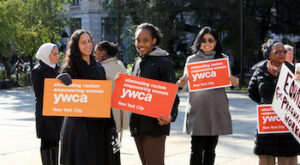
The Harlem YWCA
*The Harlem YWCA in New York City was founded on July 7, 1905. The community's founders were well connected to the networks of religious and practical organizations developed in Harlem, especially as the number of Black citizens increased. During the Great Migration, this YWCA played a crucial role in developing training and career opportunities for young Black women in the early to mid-twentieth century, while also providing safe and respectable accommodations. They combined the social traditions of clubs and religion to benefit the community.
"The objective of the Harlem YWCA was to provide a Christian family environment that supported the material and spiritual needs of young women, enabling them to advance their careers and social standing. It thus became a center for community activism as well as religious outreach. It had its motto," The More Abundant Life."The objective of the Harlem YWCA was to provide a Christian family environment that supported the material and spiritual needs of young women, enabling them to advance their careers and social standing. It thus became a center for community activism as well as religious outreach. It had its motto, The More Abundant Life.
The foundation and development of the Harlem Young Women's Christian Association was led by Cecelia Cabaniss Saunders, Emma Ransom, and Virginia Scott, among others. Saunders served as the executive director from 1914 to 1947. The Harlem branch's development reflected the tensions and changes in American society between white and Black citizens. Indeed, the YWCA movement was formally segregated by skin color until 1945, and the leaders of the Harlem YWCA led demands for the independence of YWCAs for Black women from supervision by YWCAs for White women. This resulted in changes to the official organizational rules in 1946, which granted self-governance to the YWCAs for Black women.
Premises and activities
The Harlem organization initially rented premises and mainly provided bible study and a Sunday evening religious service. However, the founders also responded to the demand and obvious need for secular support. In 1921, it re-opened in a purpose-built building at 137th Street and Lenox Avenue after occupying rented premises. This building, funded by the Rockefellers, set a high standard for the YWCA. The building had a large cafeteria in the basement. The ground and first floors housed an information desk, offices, reception, meeting rooms, and teaching rooms.
On the higher floors was a gymnasium with showers, a locker room, and a laundry. There was a swimming pool on the fourth floor. An adjacent building provided the accommodation rooms for residents. By 1926, the Emma Ransom House could accommodate over 200 women, including a roof garden with lighting. There needed to be more tension between the rules, well-meaning supervision for residents, and their wish for an independent life. Later, an annex, more classrooms, and a trade school were developed. By 1943, over 3,000 students were enrolled. By 1947, the Harlem YWCA employed over a hundred people.
The Harlem YWCA provided training in domestic work in areas such as cooking and sewing, and taught me how to balance the need to work with a successful home life. These skills made the women more competitive in the job market. In 1923, Emma Shields Penn was hired to lead the trade school in expanding its training offerings. She had been previously employed at the U.S. Department of Labor. She expanded her training to include business skills such as shorthand, dictation, bookkeeping, business English, and additional domestic service skills, as well as beauty school.
Madame C. J. Walker was a member of the Harlem YWCA's management committee until her death, and her success through her beauty products company provided an example of a very successful woman. There was also a cultural course program, with the content changing depending on their popularity and the availability of lecturers. It later expanded into nursing studies, offering a formal state qualification, including practical hospital placements from around 1939. The Harlem YWCA also established an employment bureau in the mid-1930s, and members of the organization's committee began promoting better employment conditions, particularly for domestic staff.
These employment-related activities were led by the then membership secretary, Anna Arnold Hedgeman (who resigned in 1933). She also expanded the series of career and inspirational lectures, booking women such as Mary Church Terrell, Charlotte Hawkins Brown, and Maggie L. Walker. The accommodation was a cheap, safe, and respectable place for young Black women to stay temporarily in New York. This was particularly important in the earlier years of the Harlem YWCA. Among people known to have lived there was Leontyne Price in 1948 while attending the Juilliard School.